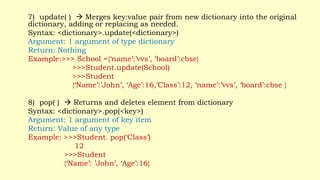This document defines and provides examples of using dictionaries in Python. It explains that dictionaries are mutable collections of key-value pairs that are indexed by keys rather than integers. Keys must be unique and immutable, while values can be of any type. The document outlines how to create, access, traverse, modify, and perform operations on dictionary elements using various syntax and functions like dict(), [], pop(), update(), keys(), values(), and more.
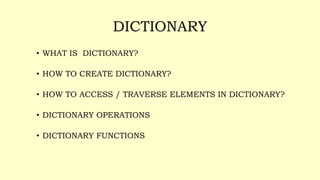
![WHAT IS DICTIONARY?
• It is unordered collection of elements in the form key:value pair.
• Keys must be of immutable type such as string,number or a
tuple.
• Values can be of any type.
• It is Mutable.
• Indexed by keys not by Numbers.
• Keys must be unique.
• Dictionaries are also called ‘associative arrays’ or ‘mappings’ or
hashes.
• Examples:
• D1 = { }
• Signal = {‘Red’:1, ‘Green’:2, ‘Yellow’:3}
• Dict1={1:’test’, ‘string’: 2, ‘list’:[1,2,3], (5,7):’tuple’}](https://image.slidesharecdn.com/ch13dictionary-220814174410-37432f80/85/Ch_13_Dictionary-pptx-2-320.jpg)
![How to create Dictionary?
1) Initialisation
Signal = {‘Red’:1, ‘Green’:2, ‘Yellow’:3}
2) Using dict( )
1) D = dict( ) Creates Empty dictionary
2) Signal = dict(Red=1,Green=2, Yellow=3)
3) Signal = dict([‘Red’,1],[‘Green’,2],[‘Yellow’,3])
4) Signal = dict(zip((‘Red’,’Green’,’Yellow’),(1,2,3)))](https://image.slidesharecdn.com/ch13dictionary-220814174410-37432f80/85/Ch_13_Dictionary-pptx-3-320.jpg)
![HOW TO ACCESS ELEMENTS IN A DICTIONARY?
• In Dictionary, the elements are accessed through keys.
Syntax: <DictionaryName>[<key>]
Months={‘Jan’:31,’Feb’:28,’Mar’:31,’Apr’:30,’May’:31}
Vowels={1:’a’, 2:’e’, 3:’i’, 4:’o’, 5:’u’}
>>>Months[‘Feb’]
28
>>>Months[‘May’]
31
>>>Vowels[3]
I
>>>Vowels[‘e’]
Error Message](https://image.slidesharecdn.com/ch13dictionary-220814174410-37432f80/85/Ch_13_Dictionary-pptx-4-320.jpg)
![Traversing a Dictionary
Syntax:
for <item> in <Dictionary> :
item Keys in dictionary
Dictionary[item] Value corresponding to key
Ex:1
D1={‘Red’:1, ‘Green’:2, ‘Yellow’:3}
for key in D1:
print(key, D1[key])
Output:
Red 1
Green 2
Yellow 3
for i in D1:
print(D1[i])
Output: Output:
1 2
2 1
3 3
Dictionaries are unordered set of
elements, the printed order of elements
is not same as the order you store the
elements in.](https://image.slidesharecdn.com/ch13dictionary-220814174410-37432f80/85/Ch_13_Dictionary-pptx-5-320.jpg)
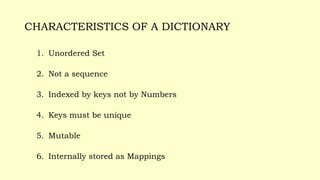
![Dictionary Operations
Student={‘Name’:’John’, ‘Age’:16}
1) Adding Elements to Dictionary
Syntax: Dictionary[key] = value
>>> Student[‘Class’]=12
>>> Student
{‘Name’:’John’, ‘Age’:16,’Class’:12}
2) Updating Existing elements
Syntax: Dictionary[key]=Newvalue
Ex: Student[‘Age’]=17
Result: Student={‘Name’:’John’, ‘Age’:17}
Student[‘age’]=18
Result: : Student={‘Name’:’John’, ‘Age’:17, ‘age’:18}](https://image.slidesharecdn.com/ch13dictionary-220814174410-37432f80/85/Ch_13_Dictionary-pptx-7-320.jpg)
![3) Deleting Elements from Dictionay
i) Using del statement
Syntax: del dictionary[key]
>>>del Student[‘age’]
>>>del Student
>>>del Student[‘DOB’]
Error Message : KeyError: 'DOB‘
ii) Using pop( ) method
Syntax: <Dictionary>.pop(<key>)
>>>Student.pop(‘Age’)
16](https://image.slidesharecdn.com/ch13dictionary-220814174410-37432f80/85/Ch_13_Dictionary-pptx-8-320.jpg)
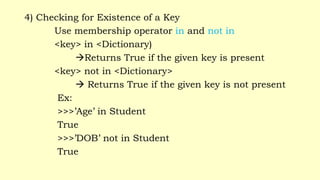
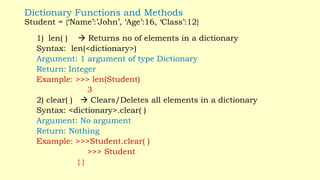
![3) get( ) Get the item with given key or User defined message
Syntax: <dictionry>.get(key , [default])
Argument: 1 – Essential argument, 1 – Optional argument
Return: Object/ Value
Example: >>> Student.get(‘Name’)
John
>>>Student.Get(‘dob’, “Key does not exist”)
Key does not exist
4) items( ) Returns all the items in the dictionary as (key,value) tuple
Syntax: <dictionary>.items( )
Argument: No argument
Return: Sequence of (key, value) pair
Example: >>>Student.items( )
dict_items([('Name', 'John'), ('Age', 17), ('Class', 12)])](https://image.slidesharecdn.com/ch13dictionary-220814174410-37432f80/85/Ch_13_Dictionary-pptx-11-320.jpg)
![5) keys( ) Returns all the keys in dictionary as a list.
Syntax: <dictionary>.keys( )
Argument: No argument
Return: List of keys
Example: >>> Student.keys( )
[‘Name’, ‘Age’, ‘Class’]
6) values( ) Returns all the values in dictionary as a list.
Syntax: <dictionary>.values( )
Argument: No argument
Return: List of values
Example: >>> Student.values( )
[‘John’, 16,12]](https://image.slidesharecdn.com/ch13dictionary-220814174410-37432f80/85/Ch_13_Dictionary-pptx-12-320.jpg)
